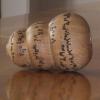symmetry
Celebrating the 150th anniversary of Maxwell's equations we talk to physicist John Ellis about what they mean for modern technology and our understanding of the Universe.
An impossible equation, two tragic heroes and the mathematical study of symmetry.
Why (some) physicists want to modify Einstein's general theory of relativity.
Physicists love symmetry, but they get even more excited about symmetry breaking. They even believe that many of the features of the world we live in are a result of it. What do they mean by that?
The laws of symmetry are unforgiving, but a team of researchers from the US have come up with a pattern-producing technique that seems to cheat them. The new technique is called moiré nanolithography and the researchers hope that it will find useful applications in the production of solar panels and many other optical devices.
On the face of it, an artist and a theoretical physicist might seem an unlikely pairing. But Turner Prize-winning sculptor Grenville Davey and string theorist David Berman's collaboration is producing beautiful, thought-provoking work inspired by the fundamental structure of the Universe. Julia Hawkins interviewed them to find out more about how the Higgs boson and T-duality are giving rise to art.
In the first part of this article we explored Landau's theory of phase transitions in materials such as magnets. We now go on to see how this theory formed the basis of the Higgs mechanism, which postulates the existence of the mysterious Higgs boson and explains how the particles that make up our Universe came to have mass.
If you're interested in maths then Marcus du Sautoy does not really need an introduction: he is well known for his TV and radio appearances and popular maths books. And he's also written for Plus in the past. In this interview he chats about his work as a mathematician and maths populariser.
Imaginary is an interactive mathematics exhibition that inspires the imagination with beautiful images. And what is more exciting it allows anyone to step into the world of maths and play with beautiful mathematical surfaces, symmetry and much more. We went along to the Imaginary Barcelona conference, which brought together people involved in the original exhibition in Germany and its recent successful run throughout Spain.
